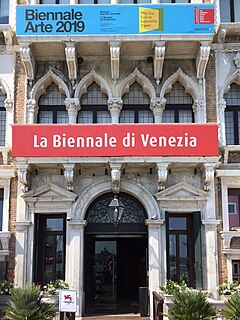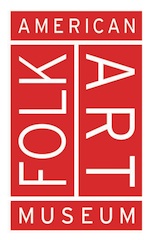
The Venice Biennale is an arts organization based in Venice and the name of the original and principal biennial exhibition the organization presents. The organization changed its name to the Biennale Foundation in 2009, while the exhibition is now called the Art Biennale to distinguish it from the organization and other exhibitions the Foundation organizes.

Maurizio Cattelan is an Italian artist. Known primarily for his hyperrealistic sculptures and installations, Cattelan's practice also includes curating and publishing. His satirical approach to art has resulted in him being frequently labelled as a joker or prankster of the art world. Self-taught as an artist, Cattelan has exhibited internationally in museums and Biennials. In 2011 the Guggenheim Museum, New York presented a retrospective of his work. Some of Cattelan's better-known works include America, consisting of a solid gold toilet; La Nona Ora, a sculpture depicting a fallen Pope who has been hit by a meteorite; and Comedian, a fresh banana duct-taped to a wall.

The American Folk Art Museum is an art museum in the Upper West Side of Manhattan, at 2, Lincoln Square, Columbus Avenue at 66th Street. It is the premier institution devoted to the aesthetic appreciation of folk art and creative expressions of contemporary self-taught artists from the United States and abroad.

Flash Art is a contemporary art magazine, and an Italian and international publishing house. Originally published bilingually, both in Italian and in English, since 1978 is published in two separate editions, Flash Art Italia (Italian) and Flash Art International (English). Since September 2020, the magazine is seasonal, and said editions are published four times a year.
Daniel Hesidence is an American painter who lives and works in Long Island City, New York. Hesidence received his BFA from the University of Tampa, Florida in 1998, and completed his MFA at Hunter College, New York in 2001.
Enrico David is an artist based in London. He works in painting, drawing, sculpture and installation, at times employing traditional craft techniques. In the 1990s he garnered acclaim for creating monumental embroidered portraits using sewn canvases, which often began as drawings and collages from fashion magazines. During the past several years David focused on sculpture in a variety of media and returned to more traditional methods of painting. His recent works include large-scale portraits of deeply psychological meaning. Drawing continues to be an important element of his practice.

Stefano Cagol is an Italian contemporary artist living in Italy, Germany and Norway. He works with video, photography and installation and performance art in the fields of conceptual art, environmental art / eco art and land art, and has reflected for years on borders, viruses, flags and climate issues.
James Castle was an American artist born in Garden Valley, Idaho. Although Castle did not know about the art world outside of his small community, his work ran parallel to the development of 20th-century art history. His works have been collected by major institutions. The Philadelphia Museum of Art organized a retrospective of Castle's work which toured nationally in 2008–09. Castle's work entered the international arena with a major exhibition in Madrid, Spain at the Museo Nacional Centro de Arte Reina Sofía in 2011 and was included in the 2013 Venice Biennale exhibition The Encyclopedic Palace. In 2014 The Smithsonian American Art Museum featured their recent acquisition in the exhibition Untitled: The Art of James Castle and the Whitney Museum of American Art included their acquired collection of Castle's work in the 2017 exhibition Where We Are.
Luca Campigotto is an Italian artist photographer and writer.

Bart Dorsa is an American artist, photographer, film-maker. Dorsa works in an old photographic technique. Dorsa's notable exhibitions have been at the Venice Biennale and Moscow Museum of Modern Art. In 2011 Dorsa pedaled his Flaming Duck kinetic sculpture around the city of Moscow.

Massimiliano Gioni is an Italian curator and contemporary art critic based in New York City, and Artistic Director at the New Museum. He is the Artistic Director of the Nicola Trussardi Foundation in Milan as well as the Artistic Director of the Beatrice Trussardi Foundation. Gioni was the curator of the 55th Venice Biennale in 2013.

Marino Auriti (1891–1980) was an Italian-born American self-taught artist. An auto-mechanic by trade, Auriti is best known for his 1950s architectural model The Encyclopedic Palace of the World. Auriti designed Encyclopedic Palace/Palazzo Enciclopedico/Palacio Enciclopedico/Palais Encyclopédique or Monumento Nazionale. Progetto Enciclopedico Palazzo to house the entirety of worldly knowledge and human discovery: "all the works of man in whatever field, discoveries made and those which may follow."

(E-E) Evgenij Kozlov is a Russian artist living in Berlin. Known chiefly as a founder member of the influential art group "New Artists", he works under the artist’s name of E-E which has been his sole signature since 2005.
Emma Kunz (1892–1963) was a Swiss healer, researcher, and artist. She published three books and produced many drawings.
Bouchra Khalili is a Moroccan-French visual artist. Raised between Morocco and France, she studied Film at Sorbonne Nouvelle and Fine Arts at École nationale supérieure d'arts de Paris-Cergy. She lives in Berlin, Germany.
The 55th Venice Biennale was an international contemporary art exhibition held in 2013. The Venice Biennale takes place biennially in Venice, Italy. Artistic director Massimiliano Gioni curated its central exhibition, "The Encyclopedic Palace".

The Angolan pavilion, representing the nation of Angola, has participated in the Venice Biennale since 2013. As one of the biennial international art exhibition's national pavilions, Angola mounts a show in a Venetian palazzo outside Venice's Giardini. The first Angolan pavilion, which featured the photography of Edson Chagas, became the first African national pavilion to receive the biennial's top prize, the Golden Lion for best national pavilion. Chagas displayed poster-sized photographs of resituated, abandoned objects and weathered architecture in the Angolan capital of Luanda. Reviewers praised the interplay between the photographed subject matter and the Italian Renaissance artwork that adorned the hosting palazzo's walls. The 2015 Biennale hosted a group show of five Angolan artists on themes of intergenerational dialogue.
The 52nd Venice Biennale was an international contemporary art exhibition held in 2007. The Venice Biennale takes place biennially in Venice, Italy. Artistic director Robert Storr curated its central exhibition, "Think with the Senses, Feel with the Mind".
The 59th Venice Biennale is an upcoming international contemporary art exhibition to be held between April and November 2022. The Venice Biennale takes place biennially in Venice, Italy. Artistic director Cecilia Alemani will curate its central exhibition.
Cecilia Alemani is an Italian curator based in New York City. She is the Donald R. Mullen, Jr. Director & Chief Curator of High Line Art and the Artistic Director of the 59th Venice Biennale in 2022. She previously curated the 2017 Biennale's Italian pavilion and served as Artistic Director of the inaugural edition of the 2018 Art Basel Cities in Buenos Aires, held in 2018.










